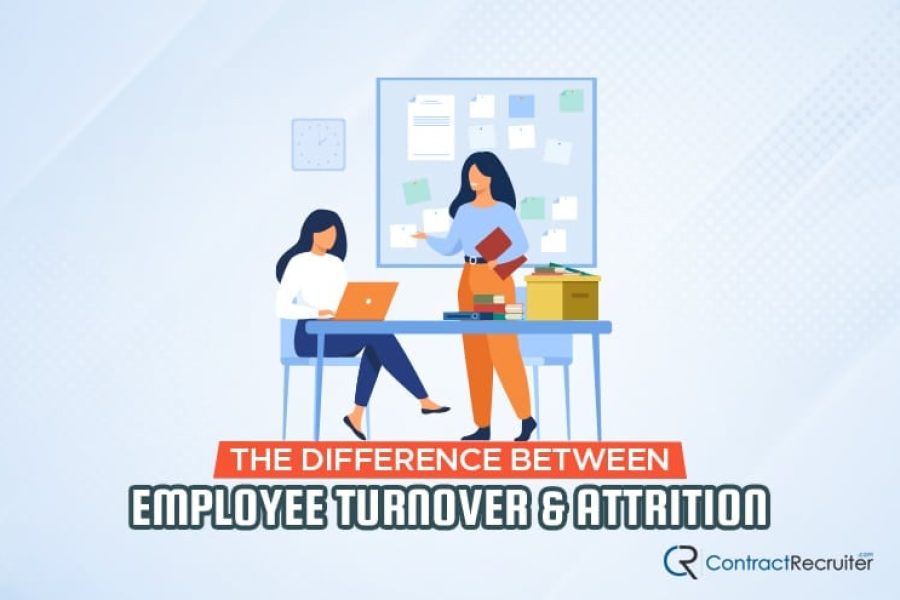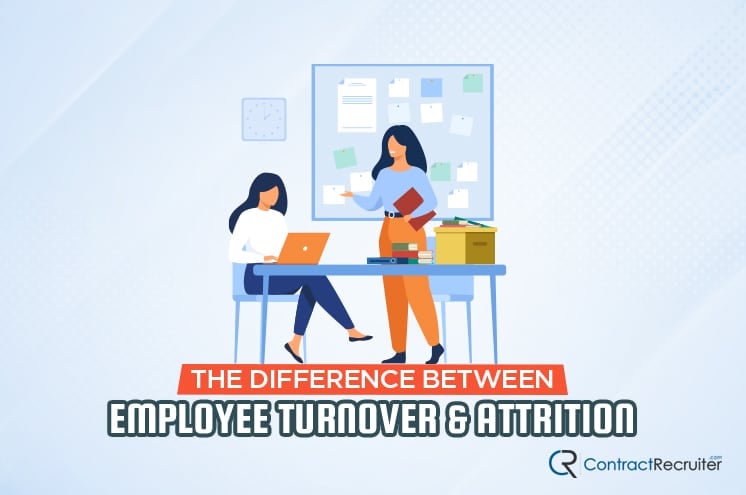In business and, specifically, in HR, specific terms often have very similar meanings in everyday language but very specific, different definitions within the HR sphere. Two such terms are Employee Attrition and Employee Turnover.
Both turnover and attrition have to do with employees leaving the organization. However, both metrics have specific definitions that measure different aspects of the overall health of a business.
Why the Confusion?
The truth is, turnover and attrition are tricky to define because so many different organizations fail to stick to conventional definitions. LinkedIn has people posting industry standard definitions, but their Insights reports describe attrition using the definition of turnover. Companies like SpriggHR define attrition with a slightly more expansive definition that includes involuntary departures.
What’s important is that you know what the metrics mean within your company and what they mean with any company you’re comparing yourself to. Any benchmarking requires you to compare apples to apples, after all.
What, then, are the industry standard definitions?
What is Employee Turnover?
To start, let’s talk about employee turnover. Many people believe that turnover is simply a measurement of the number of employees who leave an organization in a given year. However, this isn’t strictly true.
Employee turnover can be defined as “the rate at which employees leave and are replaced.” It’s also defined as a percentage of your total workforce.
- Turnover can include employees leaving voluntarily or involuntarily.
- Turnover is a percentage of your company’s average headcount during the time you’re measuring.
- Turnover isn’t necessarily bad but can be a measure of overall company performance when benchmarked against other industry players.
To calculate your turnover rate, you need to know the number of employees who leave whose roles you intend to fill. Whether or not you’ve filled them doesn’t strictly matter, but if you “intend” to fill a role but leave it unfilled for over a year, well, you don’t intend to fill it, do you?
The equation for turnover rate is this:
- Turnover Rate = (# of Departures / Average Headcount) * 100
Let’s say your company is a mid-sized business with an average of 170 employees over the last year. During that time, 22 employees left. Some were fired, others left of their own accord, but they all filled essential roles that you want to be filled, so they’re all valid for replacement.
- Turnover Rate = (22 / 170) * 100
- Turnover Rate = (0.1294…) * 100
- Turnover Rate = 12.9%
It’s important to note that turnover rates vary extremely widely. Retail employees have an extremely high turnover rate, at around 60%. Conversely, industries like the Energy or Chemicals sectors have approximately 12%. You can see a comparison and a more detailed breakdown from SHRM here.
What is Employee Attrition?
Employee attrition is the number of employees who voluntarily leave the organization and who you choose not to replace. For example, say your organization has four middle managers. One of them decides to leave to take an upper management role at a different company. Upon evaluation, you determine that you don’t need that fourth manager role, and a simple restructuring will divide their reports amongst your remaining three managers. This loss of a role is attrition.
- Attrition requires that the employee leave voluntarily; terminating or otherwise letting an employee go does not constitute attrition.
- Attrition requires that you do not fill the role. It is, essentially, a shrinkage in your workforce.
- Attrition brings with it particular challenges, such as declining interest in your products or an impending knowledge-transfer crisis.
There’s an interesting line to draw here. Since attrition requires you to have no intention of filling the role, it can be very similar to a case where you’re eliminating a role. However, eliminating a role and terminating the employee in that role wouldn’t fall under attrition because the employee departing is not leaving of their own volition. That quirk catches many people, even HR professionals, off-guard.
Is Turnover Good or Bad?
Many people have an inherent view that turnover is bad. The truth is, employee turnover isn’t always bad, and to understand it, you need to understand the context surrounding it.
Take, for example, a customer service position. Such a position is likely to have an extremely high turnover rate. Very few people want to work as a cashier for Burger King or as a Walmart greeter for an entire career. These positions are expected to be a) always filled, and b) have strong demand, as entry-level employment (or as employment of last resort for those who need income, no matter how they find it).
An industry, or a department within a company, can have very high turnover rates and not be at risk in any way.
Consider a company like Trader Joe’s. Trader Joe’s has a company culture of promoting internally, boasting that 78% of their managers started as entry-level workers, and 100% of store managers were promoted from department managers. Their entry-level roles may have high turnover, but they aren’t losing institutional knowledge; many of those employees are still employed by the company and are building loyalty through career progression.
Turnover can also be planned. Significant seasonal shifts in hiring in retail, for example, are planned turnover.
The roles will be filled (even if it takes until the beginning of the next season to fill them), so it’s not a bad thing to have a high level of turnover; it’s expected as a way to handle seasonal shifts in demand.
“A host of factors influence turnover. Voluntary turnover happens when employees unexpectedly find a better opportunity elsewhere. That may mean fewer hours, greater pay, better work-life balance, or even closer proximity to their house. It’s up to you to start sorting through the data to see how to reduce it.” – David Cusick, via Lattice.
Turnover is only bad if and when it is unplanned and when the job market is poor. If large numbers of employees leave for reasons like unequal industry pay or poor working conditions, that form of turnover is bad. If large numbers of employees leave and you can’t find people willing to work for you despite wanting to fill their roles, that isn’t good either.
The key to adequately learning about turnover, and using it to your benefit, is understanding the context. You can ask yourself questions about it, such as:
- Which departments have high turnover rates?
- What pressures result in higher turnover, such as compensation?
- Are there individuals potentially responsible for excessive turnover, like a problematic manager?
- How does the turnover rate for this department and industry compare to similar rates for other companies?
Some amount of turnover is inevitable. After all, no company in the world has a 100% retention rate. The key is to make sure your turnover rate isn’t inordinately high, and if it is, figure out what the problem is and how to solve it.
“Turnover metrics are valuable from a legal perspective because they can uncover unconscious bias, discriminatory practices, or reveal a workplace climate that deters women or persons of color from remaining at the company,” said Robert C. Bird, a professor at the Academy of Legal Studies in Business, via Lattice
Is Attrition Good or Bad?
Attrition is defined as employees who voluntarily leave and whose positions you choose not to fill. It’s already better than other employee churn metrics because it’s voluntary on both sides: the employee isn’t being terminated, and you’re choosing not to fill the role. However, the pressures that inform those choices can determine whether attrition is good or bad.
Attrition typically can provide an opportunity. For example, when interest in your product or your company is on the decline, attrition can be an amicable way to reduce overall labor costs and workforce size without resorting to downsizing. You benefit from lower operating costs without making it feel like your business is collapsing under external pressures.
The decision of an employee to depart is typically more amicable, though it doesn’t have to be. An employee choosing to quit because your pay rates are sub-standard is still, technically, an amicable departure; however, the realization that better things are possible can drive many other employees to leave for similar reasons.
Attrition is also a sign that you need to ensure that your company has a central knowledge base, and that knowledge and skills can transfer to new employees without losing institutional knowledge. One of the worst risks of attrition is departing employees bringing essential business information or skills with them, leaving the company worse off without them.
Attrition isn’t indefinite, either. Understanding when you want to fill a role and when to eliminate it in the future is an important decision to make. Choosing not to fill an open role in the short term can be beneficial, but you may still want to have someone in that role a year or two from now.
“The question isn’t whether employee attrition happens when employees leave—it’s really how long the period of attrition should last. An immediate rehiring effort turns a departure into a turnover event, with costs and anticipated benefits of its own. An indefinite period of attrition saves money in the short run but has long-term impacts due to the reduction in staff.” – Bamboo HR.
Using Turnover and Attrition to Scale Business
Businesses need to be balanced.
If you don’t have enough employees to meet demand, your business will suffer. Customers may go unfulfilled, orders can take ages to ship, customer service falters; critical understaffing can be a death knell for a company with an otherwise significant amount of demand and potential.
Conversely, if your business has more employees than are necessary, you run into the opposite problem. Expenses for maintaining your workforce skyrocket compared to income and profits. Employees may find themselves sitting on their hands with nothing to do. You end up with a “too many cooks in the kitchen” situation and can even inhibit the productivity of your teams by trying to influence too many voices on too few decisions.
Additionally, departments within a business must be in balance. If you have too few customer service employees and too many sales employees, customers may find promises being broken and service as sub-par. Too much marketing can build too much demand that the rest of your workforce isn’t prepared to handle.
The key is to recognize that turnover and attrition are not inherently bad. Attrition can be a helpful tool to adjust the scope of a business downward without inhibiting business growth. Indeed, limited availability can even increase demand, and a waitlist can be a potent marketing tool.
Monitoring these metrics is also crucial for predicting future performance and watching for potential problems.
For example, if your business is expecting a 15% or lower turnover rate for Q4, but afterward, you find that your turnover rate hit 22%, you can start to look into what happened and why. You had an expectation, which was off-base. Was it poor predictions, or was there another factor that influenced turnover and increased it? Moreover, is that something you can fix for the benefit of your business?
One key is communication. You can’t tell whether turnover or attrition is good or bad without understanding why an employee is leaving. If you’re terminating them, you know the immediate reason why. However, you may want to dig deeper to determine if external or internal pressures led to the problems you terminated them for. Ideally, of course, you will know this before you reach the point of termination, but that isn’t always possible.
The crux of the issue is that both turnover and attrition are similar metrics and serve similar purposes but are distinct and valuable in unique ways. Using them appropriately begins with measuring them correctly, and to do that, you need to know precisely what they are.
Do you or your business have any questions about the differences between employee turnover and attrition, or about either one separately? If so, please feel free to leave a comment down below, and we’ll get a conversation started! As we mentioned earlier, it is pretty easy to mix up the two, so we would be more than happy to clear up any confusion you may be having.








